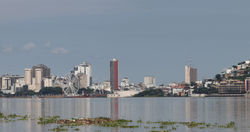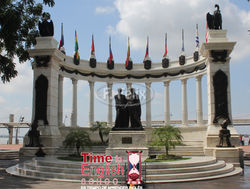
Guayaquil-Ecuador
 |  |  |
|---|---|---|
 |  |  |
 |  |  |
 |
Guayaquil the best place to visit
Is the largest and the most populous city in Ecuador, with a metro area population exceeding 3.3 at the end of 2010, as well as that nation's main port. The city is the capital of the Ecuadorian province of Guayas and the seat of the namesake canton. City of Guayaquil, Ecuador Guayaquil is located on the western bank of the Guayas River, which flows into the Pacific Ocean at the Gulf of Guayaquil. Because of its location, the city is the center of Ecuador's business and manufacturing industries.
Guayaquil was founded on July 25, 1538, with the name Muy Noble y Muy Leal Ciudad de Santiago de Guayaquil (Most Noble and Most Loyal City of St. James of Guayaquil) by Spanish Conquistador Francisco de Orellana. Even before it was founded by the Spanish, it already existed as a native village. In 1600 Guayaquil had a population of about 2,000 people; by 1700 the city had a population of over 10,000. In 1687, Guayaquil was attacked and looted by English and French pirates under the command of George d'Hout (English) and Picard and Groniet (Frenchmen).
Of the more than 260 pirates, 35 died and 46 were wounded; 75 defenders of the city died and more than 100 were wounded. The pirates took local women as concubines. In 1709, the English captains Woodes Rogers, Etienne Courtney, and William Dampier along with 110 other pirates, looted Guayaquil and demanded ransom; however, they suddenly departed without collecting the ransom after an epidemic of yellow fever broke out. On October 9, 1820, almost without bloodshed, a group of civilians, supported by soldiers from the "Granaderos de Reserva", a battalion quartered in Guayaquil, overwhelmed the resistance of the Royalist guards and arrested the Spanish authorities.
Guayaquil declared independence from Spain, becoming Provincia Libre de Guayaquil, and José Joaquín de Olmedo was named Jefe Civil (Civil Chief) of Guayaquil. This would prove to be a key victory for the Ecuadorian War of Independence. On July 26, 1822, José de San Martín and Simón Bolívar held a famous conference in Guayaquil to plan for the independence of Spanish South America. In 1829, the city was invaded by the Peruvian Army, which occupied it for seven months. In 1860, the city was the site of the Battle of Guayaquil, the last of a series of military conflicts between the forces of the Provisional Government, led by Gabriel García Moreno and General Juan José Flores, and the forces of the Supreme Chief of Guayas, General Guillermo Franco, whose government was recognized as possessing sovereignty over the Ecuadorian territory by Peruvian president Ramón Castilla.
Large portions of the city were destroyed by a major fire in 1896. On July 8, 1898, the Guayaquil City Hall "Muy Ilustre Municipalidad de Guayaquil" officially recognized the anthem written by José Joaquín de Olmedo in 1821, with the music composed by Ana Villamil Ycaza in 1895, as the "Himno al 9 de Octubre" Canción al Nueve de Octubre, most widely known now as the "Himno a Guayaquil" (Guayaquil Anthem).